Steve Field was doing repairs at a local slaughterhouse when his pager sounded, its urgent beeps interrupting the hisses and pops of his welder’s torch. Sparks from a heavy-duty mulcher had ignited a grassfire at a nearby farm, and the flames were spreading rapidly across the grazing land, threatening hundreds of sheep and dozens of towering wind turbines.
The maintenance worker shut off his torch and switched gears, stepping into his role as first lieutenant for the Country Fire Authority’s Pomonal Rural Fire Brigade.
He checked an app on his phone to see which firefighters would be heading out to the fire and co-ordinated a location for the truck to pick him up en route. It was a Monday afternoon in February, late in the Australian summer.
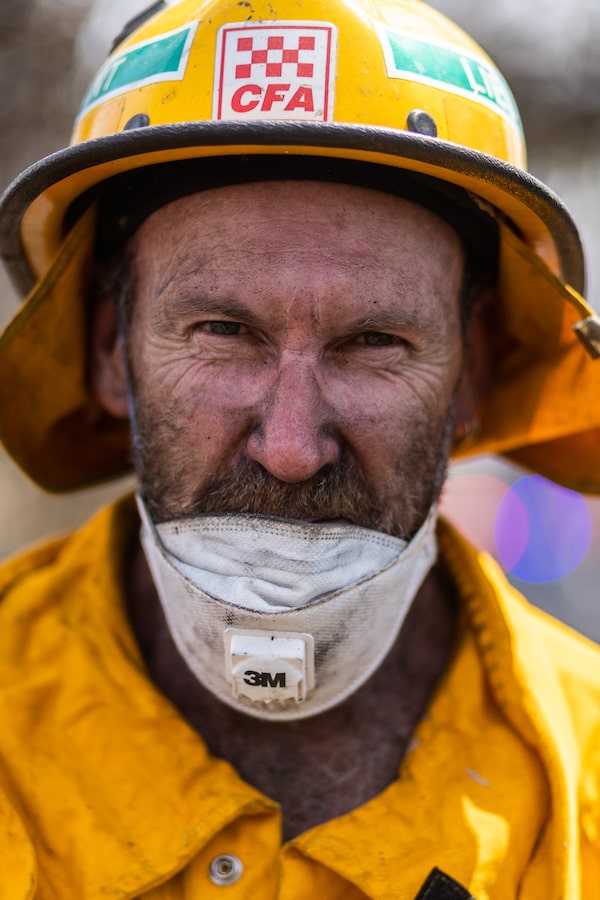
Volunteer firefighter Steve Field suited up for duty after grass ignited at a farm in his area.
Mr. Field, 52, is one of more than 140,000 volunteer firefighters who make up Australia’s unique system of bushfire response. While many countries use volunteer “firies,” none depend on them so much as the Land Down Under, where frequent hot and dry conditions, vast areas of forests and grasslands and highly flammable fuel types such as eucalyptus trees have made it one of the most fire-prone regions in the world.
Here, about 90 per cent of firefighters are unpaid. It’s an arrangement that dates back to the mid-1800s, when farmers and those living in rural communities self-organized to create firefighting services where there were none.
In Canada, the majority of all firefighters are volunteers, but wildland fire management falls largely under the jurisdiction of provincial and territorial agencies that employ seasonal and full-time employees. However, with the country now experiencing its worst wildfire season of the 21st century, before even the start of summer, some agencies are actively exploring how they can bolster their wildfire response – and they could look to Australia’s community-based volunteers for lessons.
The Canadian government is already exploring the expansion of such initiatives, funding a five-year program, now in its pilot phase, to train community-based firefighters to respond to wildfires in remote and Indigenous communities. More than 300 Indigenous firefighters and 125 Indigenous fire guardians across Canada are expected to be hired and trained this season.
Meanwhile, in British Columbia – where three record wildfire seasons in five years stretched provincial firefighting resources beyond capacity – fire officials are rethinking their relationship with rural residents who defied evacuation orders and risked hefty fines to fight back flames with their own equipment.
They’ll need to navigate thorny issues, including liability, insurance and training – challenges that Australia has grappled with over the last decade. But some say it’s still worth exploring.
“By not [involving them], I would say we risk more of that underground activity, of seeing people do it on their own,” said Rob Schweitzer, executive director at the BC Wildfire Service. “By recognizing people and groups that have a skillset, an inventory and a bit of training, we can incorporate them – in a minor level, but in a safe manner.”
:format(jpeg)/cloudfront-us-east-1.images.arcpublishing.com/tgam/3LCGKYZLBFE4VJE5LNMUQZ6E6Y.jpg)
:format(jpeg)/cloudfront-us-east-1.images.arcpublishing.com/tgam/GVSPNSB3OBFALKUFANSQYP3KKE.jpg)
:format(jpeg)/cloudfront-us-east-1.images.arcpublishing.com/tgam/O2MGILMEQJEFFMHDMCNL7WLP5M.jpg)
A culture within a culture
Back in Australia, Mr. Field and his crew were among 16 units with the Country Fire Authority, or CFA, to respond to the grassfire in the town of Great Western, about 225 kilometres northwest of Melbourne.
Clad in orange wildland apparel with yellow reflective stripes and a yellow helmet, Mr. Field doused the perimeter of the fire and worked his way inward, being careful to remain upwind.
His white respirator was immediately darkened with soot.
The fire was contained in about 90 minutes, leaving behind 60 hectares of smouldering farmland and two property owners grateful that no one was injured and nothing more damaged.
Mr. Field is a second generation firie, his father having been a member of another CFA brigade for more than 50 years.
“From when I was born, we were always at the fire station, doing stuff with dad – going for a run in the fire truck, sirens and lights on,” he told The Globe and Mail as he mopped up, using a rake hoe to turn over and extinguish burning logs.

Darwin
500 km
NORTHERN
TERRITORY
QUEENSLAND
AUSTRALIA
WESTERN
AUSTRALIA
SOUTH
AUSTRALIA
NEW SOUTH
WALES
Perth
Sydney
Canberra
A.C.T.
Adelaide
VICTORIA
Change in number of dangerous
fire weather days, 1950-2020*
Melbourne
-25
-15
-5
0
5
15
25
TASMANIA
Based on the change in the annual (July to June) number of days between
the two periods: July 1950–June 1985 and July 1985–June 2020
THE GLOBE AND MAIL, source: government of south australia

Darwin
500 km
NORTHERN
TERRITORY
QUEENSLAND
AUSTRALIA
WESTERN
AUSTRALIA
SOUTH
AUSTRALIA
NEW SOUTH
WALES
Perth
Canberra
Adelaide
VICTORIA
Change in number of dangerous
fire weather days, 1950-2020*
Melbourne
-25
-15
-5
0
5
15
25
TASMANIA
Based on the change in the annual (July to June) number of days between
the two periods: July 1950–June 1985 and July 1985–June 2020
THE GLOBE AND MAIL, source: government of south australia

Darwin
500 km
NORTHERN
TERRITORY
QUEENSLAND
AUSTRALIA
WESTERN
AUSTRALIA
SOUTH
AUSTRALIA
NEW SOUTH
WALES
Perth
Sydney
Sydney
Canberra
A.C.T.
A.C.T.
Adelaide
VICTORIA
Change in number of dangerous
fire weather days, 1950-2020*
Melbourne
-25
-15
-5
0
5
15
25
TASMANIA
Based on the change in the annual (July to June) number of days between
the two periods: July 1950–June 1985 and July 1985–June 2020
THE GLOBE AND MAIL, source: government of south australia
In Australia, volunteer fire services, supported by a small number of paid staff, are responsible for providing firefighting services to rural and remote areas. In contrast, career firefighters typically work for agencies that respond to metropolitan areas. Each of the country’s six states and two territories has its own volunteer bushfire management service; New South Wales, home to nearly a third of all Australians, has the largest, with 72,855 operational and support volunteers across 1,993 brigades.
Each service has its own rules regarding minimum age, training, background checks and other requirements. Governments typically fund each fire management agency through local levies, and this money is used to purchase fire service sheds, tankers, hoses and other firefighting tools.
In Victoria, the CFA requires that volunteer firefighters be 16 years or older, complete general training that can take up to six months and attend regular meetings and training sessions. They must also live or work close enough to their brigade to respond to incidents quickly. Paid staff operating out of district headquarters support and co-ordinate volunteers.
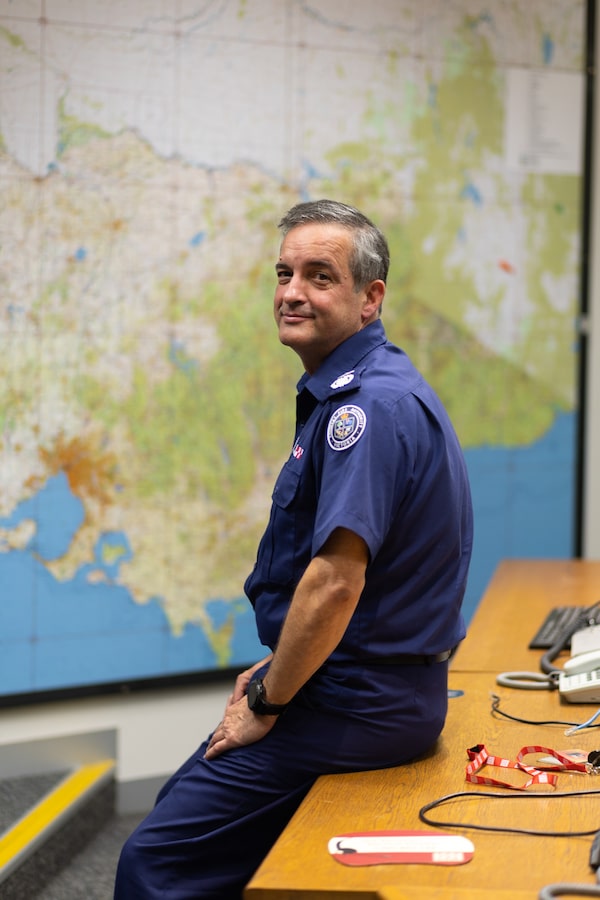
Alen Slijepcevic is the CFA's deputy chief officer of fire risk.
The CFA works with Fire Rescue Victoria, the fire agency that serves the metropolitan Melbourne area and other regional centres, on larger or more dynamic incidents. The volunteer fire management agency also partners with Forest Fire Management Victoria, which manages state forests and national parks, on planned burns to reduce fuels such as dead wood and shrubs. In emergencies, all agencies work together.
Alen Slijepcevic, deputy chief officer of fire risk, research and community preparedness at the CFA, said volunteers come from varied backgrounds, often with little in common aside from a desire to serve their communities.
At the CFA, volunteers include judges, university professors, farmers, IT specialists and maintenance workers like Mr. Field, all permitted under federal legislation to take unlimited unpaid leave from their jobs for volunteer emergency services work. “Most [firefighters] sign up so they can give something back to their community,” Mr. Slijepcevic said. “And, it’s a tradition. There’s the honour. Very frequently you’ll encounter a brigade with grandparents, parents and children at the same time.”
Treen Bangay, in blue socks, gathers with her comrades at the Woodhill Rural Fire Brigade's station.
In the state of Queensland, about 50 kilometres south of Brisbane, members of the Woodhill Rural Fire Brigade convened at their fire station in late February after conducting a pile burn for a private landowner. First Officer Ben Heilbronn picked up coffee and buns for the crew, whose members range in age from 16 to 64, to consume as they debriefed and chatted about weekend plans. He described the brigade, of which he’s been a member for 18 years, as a second family.
“It’s not just about going into battle and training hard, working hard and having a laugh,” Mr. Heilbronn said. “It’s a real sense of extended family for so many people, and that’s a culture within a culture.”
Across from him sat firefighter Treen Bangay, a car collector and drag racer with chunky gold rings, a sharp tongue and sleeve tattoo of a female firefighter. Next to her, third officer Colin Howell, a pensioner with a decades-old collection of firefighting memorabilia who quipped that he would be sitting at home twiddling his thumbs if not for the brigade. Leslie Meade, a former soldier who now works in IT, joined three years ago looking to get out of the house and socialize, finding himself drawn to the immediate and tangible rewards of the work. Dean Brunker, nicknamed “Senior” so as not to be confused with his firefighter son, signed up after leaving the military, missing the camaraderie.
“Once you’re with a group like this, you’re spending hours in trucks, at fires,” said Mr. Howell, who has been with the brigade for 26 years. “You get to know one another’s families, all of their issues. You can be the sounding board where the husband or wife is at home, you can talk about family, you can be a shoulder to cry on.”
For others, firefighting is a continuation of a tradition that existed long before the formalities of structured brigades and legislation. In the rural and remote areas of western Queensland, farmers, ranchers and others employed in similar roles make up primary producer brigades, a special classification of volunteer firefighters that are more self-sufficient than typical brigades, subject to fewer training requirements and have minimal contact with Queensland Fire and Emergency Services, or QFES, the state’s government agency responsible for firefighting. They are not unlike the ranchers and loggers of B.C., equipped with their own machinery and knowledge of the land.
QFES Deputy Commissioner Michael Wassing called these brigades a “powerful local source,” that follow a community self-help model more than any other fire service. Registering with the rural fire service offers these brigade members workers’ compensation insurance and any personal protective clothing or firefighting equipment that they may need, but they typically use their own graders, dozers and vehicles and are left to their own devices, Deputy Commissioner Wassing said.
“They don’t ask for much, and the value they provide is enormous,” he said. “So when they do want a bit of help, it’s really important that we’re there to help them, but also not to overregulate them, too.”
:format(jpeg)/cloudfront-us-east-1.images.arcpublishing.com/tgam/CWLD3LMFJBGLXLCTTRNT7732ZY.jpg)
:format(jpeg)/cloudfront-us-east-1.images.arcpublishing.com/tgam/OMDNYNC3HJBSJAJIMOFDWEQDEQ.jpg)
:format(jpeg)/cloudfront-us-east-1.images.arcpublishing.com/tgam/VTCJ2AYOMRH45LLU2BD3XDMREA.jpg)
The worst is still to come
Canada’s firefighting system already has some similarities to Australia’s, and recent changes nudge it further in that direction – albeit at a much smaller scale.
Volunteers make up about 70 per cent of all Canadian firefighters, and nearly all outside of city centres. At wildland-urban interface fires – where forests and vegetation meet communities and other human-made structures – career municipal and volunteer firefighters are typically responsible for assessing which properties are defendable, installing sprinklers and doing structural firefighting.

Firefighters: volunteer vs. career
Per cent, by country
Volunteer
Career
29%
71%
Canada
11%
89%
Australia
the globe and mail, Source: Canadian
Association of Fire Chiefs;
australian government

Firefighters: volunteer vs. career
Per cent, by country
Volunteer
Career
29%
71%
Canada
11%
89%
Australia
the globe and mail, Source: Canadian
Association of Fire Chiefs;
australian government

Firefighters: volunteer vs. career
Per cent, by country
Volunteer
Career
11%
29%
71%
89%
Canada
Australia
the globe and mail, Source: Canadian Association of Fire Chiefs; australian government
Very rarely are these firefighters on the frontlines of wildfires, but it does happen, said Ken McMullen, president of the Canadian Association of Fire Chiefs.
“Municipal firefighters have training on urban-interface firefighting, meaning that we don’t need to call in our colleagues in wildfire, necessarily, to extinguish a fire in tree-type areas,” he said. “In Canada, what’s happening right now, because resources are spread so thin of our wildland colleagues, there is a heavier reliance on our municipal firefighters actively involved in both the wildland – the edge between structure and trees – and on the forested side as well.”
In challenging wildfire seasons when provinces need assistance, the Canadian Interagency Forest Fire Centre co-ordinates resource-sharing and mutual aid, both nationally and internationally. This season has already seen some wildland firefighters sent across provinces and others arrive from the U.S., Australia, New Zealand, South Africa and Costa Rica.
In British Columbia, the BC Wildfire Service manages wildfires on both Crown and private lands, employing a network of seasonal firefighters, permanent staff and contractors. On wildland-urban interface fires, the provincial wildfire service might request assistance from a local fire department for structural protection.
It’s a system that was sufficient for more than a century, until it wasn’t; in 2017, more than 12,100 square kilometres of the province burned, shattering records, displacing 65,000 people and and overwhelming provincial resources.
“Up until about 2017, our agency had the ability to essentially suppress almost any wildfire that we wanted to, through aerial [and] ground resources, heavy equipment,” said Mr. Schweitzer, the BC Wildfire Service executive director. “But the conditions of the forests now, in conjunction with climate change and the increased lightning storms we’re seeing, we’re not able to control every fire. It overrides any level of resourcing that you could possibly have.”
The wildfire seasons are only expected to worsen. The latest report from the Intergovernmental Panel on Climate Change noted that human-caused climate change is increasing the amount of land burned by wildfire. It cited a study that found B.C.’s 2017 fires burned an area of land between seven and 11 times greater than compared with a scenario without such influence.
”As the climate continues to warm, we can expect that extreme wildfire seasons like 2017 in B.C. will become more likely in the future,” wrote the authors of the study.
:format(jpeg)/cloudfront-us-east-1.images.arcpublishing.com/tgam/KJ2KQMV6LNBHDHUFORZPI35ELM.JPG)
:format(jpeg)/cloudfront-us-east-1.images.arcpublishing.com/tgam/A35UQROJN5GQ3OSFRBNKTNYYSA.JPG)
:format(jpeg)/cloudfront-us-east-1.images.arcpublishing.com/tgam/XHVONNJ7OFD2JFRQ6QNGGOYAWQ.JPG)
:format(jpeg)/cloudfront-us-east-1.images.arcpublishing.com/tgam/ZO4OTZOWUNFZ3K4666T6BDO4PE.JPG)
In the summer of 2018, record-setting heat and severe lightning storms challenged the BC Wildfire Service like never before. In less than two weeks in August, the service responded to more than 400 new fire starts; it would become the province’s most destructive wildfire season, scorching 13,500 square kilometres of land and breaking the record set just one year prior.
In B.C.’s Central Interior, multiple fires threatened Francois Lake, a community just south of Burns Lake, known for its ranching, farming and forestry, and home to the Cheslatta Carrier Nation. With official firefighting resources taxed and livelihoods at stake, roughly 100 residents defied evacuation orders in efforts to protect their properties.
Under B.C.’s Wildfire Act, a person defying an evacuation order during a wildfire can face a fine of up to $5,000, imprisonment of up to six months, or both; the penalties grow when a state of emergency is declared and the Emergency Program Act enabled. People who do leave are not permitted to return until the order is lifted, and children are never allowed to remain in an evacuation zone even if their guardians choose to.
Among the holdouts in Francois Lake were David and Risé Johansen, owners of the Takysie Lake Resort, a community hub that also includes a grocery store, restaurant and gas station. As Mr. Johansen used their pumper truck – usually used to empty septic tanks – to extinguish lightning-caused fires, his wife saturated the property with sprinklers and garden hoses. Other residents used their own heavy equipment to construct fire guards.
On good days, there were no signs of fire. On bad days, the sky was coloured in grey and orange, and a sleepless Ms. Johansen would stay up to video record the store inventory for insurance purposes, wondering if they would have to hop on a boat to escape the flames advancing from over the hill.
As part of the evacuation order, the regional district restricted ferry access, the main access point to the community, angering residents who were prevented from stocking up on supplies. Ms. Johansen recalled with frustration tense interactions with police enforcing the evacuation order, including one incident in which an RCMP officer jumped on the hood of their car as they tried to drive past a checkpoint, and another in which officers asked for her dental records so that they could later identify her remains. BC Wildfire Service crews were skilled and heroic, she said, but were too few and too late.
In the end, the Johansens lost one cabin and part of the fence line, but the resort remained. Two neighbours’ homes burned down. The Cheslatta Carrier Nation lost three-quarters of its community forest.
“I can promise you that if every Southside resident had left when they told us to, there wouldn’t be a Southside left to come back to,” Ms. Johansen said.
In the aftermath of 2018, Ms. Johansen founded the Chinook Emergency Response Society (CERS), a group dedicated to preparing and mobilizing the community for future disasters. Rio Tinto, formerly Alcan, provided eight cargo trailers and one industrial trailer – with water tanks, pumps, hoses and other necessary equipment – as part of an ongoing reconciliation process with the Cheslatta, who were forcibly relocated in the 1950s to make way for an industrial project. The society has since organized formal wildfire training, hosted wildfire preparedness days and created a call list of volunteers who are prepared to respond.
:format(jpeg)/cloudfront-us-east-1.images.arcpublishing.com/tgam/3GJSMWDX7REDBMDM7XWDHF2TPE.jpg)
Fighting for more volunteer firefighters
As Canadian provinces consider whether, or how, to involve more community groups in wildfire response, it’s worth noting the challenges of the Australian model. After Australia’s catastrophic bushfire season of 2019-2020, which burned an area roughly the size of Saskatchewan, a royal commission report noted that climate change has made bushfire seasons longer, more extreme and less predictable, resulting in greater expectations and demands being placed on volunteers. International media reports on the disaster, which came to be known as Black Summer, both lauded the heroism of the country’s volunteer firefighters and questioned whether they are enough. Of 82,480 emergency services personnel to respond, 64,500, or 78 per cent, were volunteers.
A survey of more than 4,000 personnel who responded that summer found that 4.6 per cent of volunteers experienced “very high psychological distress indicative of serious mental illness,” including probable post-traumatic stress disorder. About the same amount experienced suicidal ideation – double that of the general population. Of volunteers with high need for mental health support, 58 per cent had not received any in the 12 months following the fires.
A resulting report noted that while all emergency services have policies and procedures in place to support the mental health of personnel, many are at or above capacity in ordinary times and that it will be important to consider how to scale up following major disasters.
Falling volunteer numbers raise further questions. Figures from the Australian government’s Productivity Commission show that the number of volunteer firefighters has fallen to 140,151 in 2021-22 from 173,017 nine years earlier – a 19 per cent decrease.
Fire service leaders offer a number of reasons as to why this may be. An aging population, coupled with younger people gravitating toward urban centres, is one. The Productivity Commission’s figures show that the number of paid, career firefighters grew 27 per cent to 15,157 over the same period, adding weight to the theory that urbanization is at least partly to blame. Globally, the COVID-19 pandemic also had a significant impact on work force numbers, including on volunteerism.
In Canada, volunteer firefighter numbers have similarly fallen, from 126,000 in 2016 to 90,000 in 2022 – about a 29 per cent decrease, according to an estimate by the Canadian Association of Fire Chiefs.
But a considerable part of Australia’s drop in volunteer firefighter numbers can be attributed to a growing emphasis on occupational health and safety, spelled out in ambitious targets in national guidelines, that has led to stricter training and accreditation standards. Some volunteers have pushed back against what they see as needless government bureaucracy, arguing that they are not public servants.
CFA Chief Officer Jason Heffernan said much of this tension can be traced to 2012, when Australia introduced work health and safety legislation intended to both improve workplace safety rules and harmonize them across the country. The laws dictated that employers were required to ensure the safety of workers through new protections such as specific training requirements and personal protective equipment standards, or face large fines or imprisonment. Notably, the legislation defined “workers” to include volunteers.
“Up until then, all volunteer organizations, including volunteer fire services, had a legal obligation to provide a safe work environment, and that was the extent of it,” Mr. Heffernan said. “We never had to make sure we had robust risk assessments, training programs, PPC, checks and balances. … What it meant was that we can’t just have any Tom, Dick and Harry [fighting fires].”
Mr. Heilbronn, the first officer at the Woodhill Rural Fire Brigade, said this has led to cultural clashes, particularly among those with generations of firefighting experience who are now saddled with paperwork and must undergo training that he likened to first-year university courses. He said he understood the frustration of firefighters but also the need for adequate safety protocols.
“People, at this level, don’t see why they need it,” he said. “But at a higher level, they need it to reduce WorkCover premiums, to fix workplace health and safety issues. This is a hazardous, risky job, so you have to legislate or put a whole heap of procedures around it to cover government, to say, ‘We did everything we could to protect them.’”
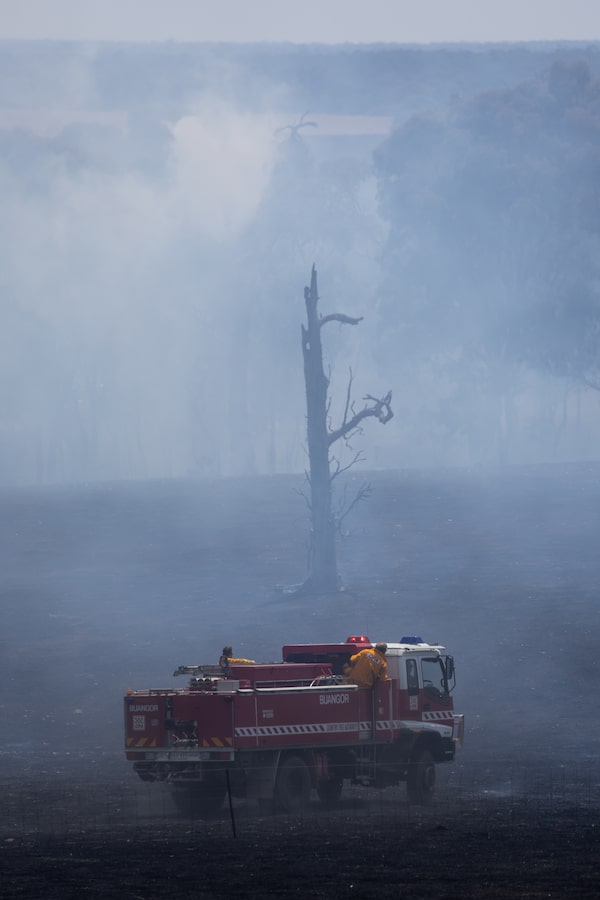
Fire services such as the CFA are changing their recruitment practices to make up for the decline in volunteers.
Deputy Commissioner Wassing said there continue to be consultations about how best to modernize the service, with particular caution to groups such as the fiercely independent primary producer brigades.
“Potentially, you just push a work force underground, and we don’t want to do that,” he said.
Kaylene Jones, deputy chief officer for operational performance and capability at the CFA, said the organization has adapted its recruitment strategy to target busy, younger would-be volunteers. This has included moving some training components online; targeted recruiting for specific roles, such as a truck driver; and offering nationally-recognized training that can be applied to full-time jobs, such as chainsaw and heavy machinery certifications.
“It’s about trying to enhance their lives, based on the fact that they’re giving up something for the service,” she said.
Asked whether a volunteer model is sustainable in the face of longer and more demanding wildfire seasons, the CFA’s Mr. Heffernan said it is precisely the surge capacity afforded by the model that makes it work. Whereas the Canadian Interagency Forest Fire Centre co-ordinates national and international resource deployment, each volunteer fire service in Australia can draw from a local pool of firefighters many times bigger.
“The reality is that there is no government that can afford the alternative,” he said. “Let’s say the 2019-2020 season, we’re talking hundreds of thousands of volunteer firefighters right across the country. We’re talking trillions of dollars needed to pay those firefighters for that one event.”
CFA chief executive Natalie MacDonald agreed, noting that the agency was able to move thousands of volunteers around the state overnight during the Black Summer fires.
“Our environment needs it,” she said. “It is the only model that is sustainable.”
:format(jpeg)/cloudfront-us-east-1.images.arcpublishing.com/tgam/QKCB6EXPURCAPEC44EEHKGABHI.jpg)
Working together
In British Columbia, the province’s recent extreme wildfire seasons forced the BC Wildfire Service to take a hard look at its sometimes frosty relationship with community groups, said Mr. Schweitzer, the executive director. Whereas once they were scolded for their defiance, they’re now being eyed for their local knowledge and desire to be part of the solution.
“There are people that have lived on these parcels of land for generations – a rancher, a logging family, people in rural settings – that have said, ‘You know what? I know as much as you do about this land, about the weather, about the topography, about the terrain and water sources.’ And up until 2017, we weren’t doing a good job engaging with them,” he said. “Frankly, it was, ‘Get out of our way. We know what we’re doing.’”
The Cooperative Community Wildfire Response project, now in its early days, will comprise two streams, Mr. Schweitzer said. The first will focus on rural Indigenous communities that may have less capacity to lead a response; on this, the wildfire service has partnered with Indigenous Services Canada, the First Nations’ Emergency Services Society and a researcher from the University of B.C. to conduct surveys on local and traditional knowledge, training and equipment. The first crew created under this partnership is the Simpcw Indigenous Initial Attack Crew, which managed numerous lightning-caused fires on their territory just north of Kamloops last summer.
A second stream will focus on ranchers, loggers and other rural community members who have already self-organized, or are willing to. The wildfire service has already met with the BC Cattlemen’s Association, as the ranching sector is expected to play a big role. In 2021, the groups trialled a joint “rancher liaison” program, with the goal of improving the flow of information between BCWS and ranchers in wildfire zones. Since then, they have created educational materials on wildfire operations, cultural sensitivities and heavy equipment safety. Last summer, 44 liaisons were trained and on standby, and seven were deployed to support BCWS and incident management teams.
BC Cattlemen’s Association General Manager Kevin Boon said ranchers are well-positioned to get involved, as most have their own excavators, bulldozers and water trucks, and have generational knowledge of the land. He said the association is hoping to partner with the BCWS on formal wildfire suppression training for interested groups in the next couple of years.
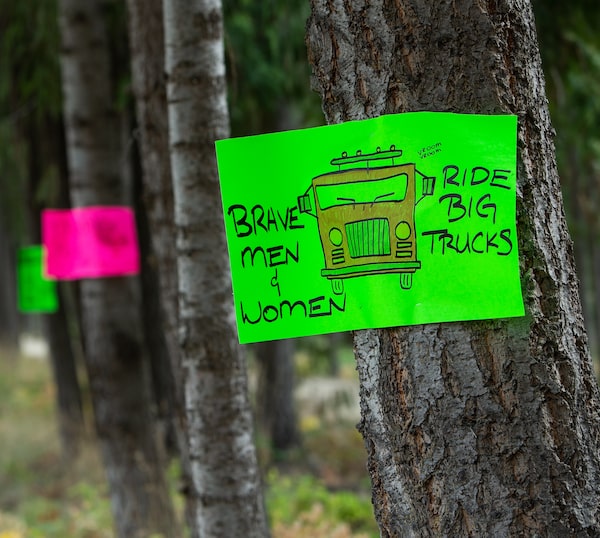
Thank-you signs in Sicamous, B.C., in 2021, when locals in T-shirts used hoses to fight spot fires in the White Rock Lake blaze. Groups in the B.C. backcountry say they could play a more organized firefighting role.
Mr. Schweitzer said while informal conversations are underway, the service is hoping to formally identify these groups – which he expects to be few, but important – by the end of the year, after which they still must work through the same issues of training, liability, coverage and risk as the Australian volunteer fire services have navigated.
Currently, only groups that are formally contracted with the BC Wildfire Service, such as the Simpcw crew, are covered. Mr. Schweitzer said the service is now mulling the creation of a society model, such as a small group of ranchers and loggers who receive training through the service, and the feasibility of extending protections to those societies.
“To be honest, that’s what’s gotten in the way for years,” he said. “But, for years, we were able to go about it on our own as an agency and do what we needed to do to suppress the fire. Now, we’re trying to figure out this hybrid model.”
Under B.C.’s Wildfire Act, government may provide compensation to those who help fight wildfires.
Another group that the wildfire service has already been in contact with is the Chinook Emergency Response Society.
They “were highly critical of our organization,” Mr. Schweitzer said, referencing the 2018 response. “We now have an equipment cache on that side and a bit of an informal protocol to say, if something starts over there and you’re able to put some heavy machinery on it, or get some water on that lightning strike, just give us a call.”
And so they have. When machinery sparked a fire in a log pile at a ranch south of Francois Lake, Ms. Johansen immediately posted about it on the society’s Facebook page and began calling neighbours, initiating a “phone tree” to inform residents and co-ordinate resources. Within half an hour, dozens of residents and two trailers were on site, and the fire extinguished.
Ms. Johansen recalled speaking with a BCWS officer and long-time Burns Lake resident who was impressed by the response. In future incidents like this, she recalled him saying, they can call BCWS and direct them to stand down so they can redirect resources.
“He really had respect for how quickly it happened, how many people responded, the cohesiveness of how they worked together, and he saw the effectiveness of it,” she said.
“There was no, ‘Oh my god, why did you do this?’ It was, you know, ‘Good job.’ So now, to be able to say to them, ‘We’ve got it. You can stand down,’ I don’t know if you can imagine what kind of a feeling that is for us.”
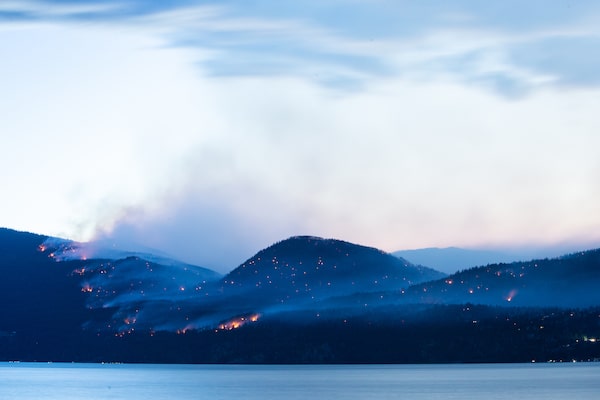
Smoke from the White Rock Lake wildfire rises over Okanagan Lake near Vernon, B.C., in 2021. With a new fire season under way, the debate continues among BCWS and communities about how to best respond to disasters like these.
The reporting of this story was made possible by the R. James Travers Foreign Corresponding Fellowship. Jim Travers, who died in 2011, believed it was crucial in today’s interconnected world for Canadian reporters to bear witness to events outside of our borders.
Wildfires and climate change: More from The Globe and Mail
Resources and explainers
Wildfire maps 2023: Tracking fires and air quality across Canada
How does wildfire smoke affect air quality and your health?
Is Eastern Canada doomed to follow the West into harsher wildfire seasons?
Commentary
John Vaillant: No wonder Alberta is on fire. We built a volcano, then threw them in
Ken McMullen and Tina Saryeddine: Canada’s overburdened firefighters aren’t getting enough support
 Andrea Woo
Andrea Woo